Frogg Mill
Frogg Mill
also known as Town Mill, Yeovil Mill and Marshes Mill
Frogg Mill, also known as Town Mill, Yeovil Mill and for a while in the eighteenth century as Marshes Mill, is thought to be the grist mill (flour mill), in what would later become the Manor of Hendford, and was mentioned in the Domesday Book of 1086 "There is a mill worth ten shillings". The mill was almost certainly a predecessor of Frogg Mill which was still operating into the twentieth century.
It was mentioned in a Terrier of 1589 "From Frogg Mill up to the Back Street..." and in 1634 Nathan, in his 'Annals of West Coker' refers to "Jeremiah Forward, miller of Yeovil".
A conveyance dated 1709 recorded "Daniell Bicknell, dyer of Taunton, Elizabeth his wife, John Cross, sergemaker of Taunton, Mary Ann his wife, Sheldon Priceman, gent of Taunton and William Whitenoll, yeoman, of Yeovil - Water grist mill called Frogg Mill with the Mill House, one garden, two orchards, and a little mead, 4 acres, in the parish of Yeovil, lately held by Henry Penny as tenant of Elizabeth Priceman, widow, deceased (another by Elizabeth Bicknell, Mary Ann Cross, and Sheldon Priceman) and now by William Whitenoll, and all houses, outhouses, buildings, water-courses, paths, ponds, banks, floodgates, hatches, wears (James Hooper of Preston Plucknett and John Darby of Yeovil, glover, as attorneys to secure possession). Endorsed: £275 received, 15 Sept 1709; possession taken 16 Sept 1709."
The mill was mentioned again in a deed for levying a fine of five shillings dated 5 June 1719 "Mary Whitenhole, widow, William Whitenhole of Yeovil, yeoman, and Thomas Lyte of New Inn, Middlesex, and James Hooper of Yeovil, gent - Moiety (or half endeale) of Water grist mill called Frogg Mill with mill-house and garden, two orchards and a little mead, 5 acres, and all houses, out-houses, edifices, buildings, ways, watercourses, paths, passages, ponds, banks, dams, streams, and floodgates, hatches, wears."
A conveyance dated 10 October 1733 recorded "William Mead of Broad Sibbure, Oxford, woolcomber, and his wife Mary, Charles Lamb of Shepton Mallet, scribbler (= wool carder), and his wife Mary, Samuel Priddle of Tintinhull, yeoman, and his wife Mary, John Hutson of Yeovil, carpenter, and his wife Grace, Samuel Mead of Roade, Somerset, husbandman, John Mead of Yeovil, Miller, Charity Mead of Yeovil, spinster, Hannah Mead of Yeovil, spinster, Joane Meade of Tintinhull, spinster, TO John Tatchell of Yeovil, innholder - Water grist mill called Frogg Mill."
An indenture dated 5 February 1779 referring to a seven-acre close "called Dodham.... near a mill formerly called Marshes Mill, now in possession of William Windsor".
In 1833 the property was owned by James Vickery but by 1846 was owned by Ann Collins.
Various trade directories, etc. In the eighteenth and nineteenth centuries recorded the millers of Frogg Mill as follows -
1733 - John
Mead, Miller of
Frogg Mill
(Deed)
1780 - Nathaniel
Stephens, Miller
& Baker
(Universal
British
Directory)
1780 - Robert
Tytherleigh,
Miller & Baker
(Universal
British
Directory)
(Tytherleigh was
actually
at Pen Mill)
1830 - Robert
Richards, Miller
of Yeovil Mill
(Pigot's
Directory of
1830)
1840 - John
Thorn, Miller of
Yeovil Mill
(Pigot's
Directory of
1830)
1841 - James
Thorn of Frogg
Mill (Register
of Voters)
1846 - Ann
Collins, Owner,
Robert Allen
Junior, Occupier
(Tithe
Apportionment)
1850 - James
Thorn, Miller of
Yeovil Mill
(Hunt & Co's
Directory)
1852 - Robert
Allen, Miller of
Yeovil Mill
(Slater's
Directory)
1866 - James
Fox, Miller of
Town Mill (Post
Office Directory
of 1866)
1875 - James
Fox, Miller of
Town Mill (Post
Office Directory
of 1875)
1894 - James
Vickery, Miller
(Kelly's
Directory of
1894)
During the 1850s the mill and surrounding lands were owned by the Collins family but on Christmas Eve 1869 James Vickery bought the mill and land to the southwest from the Collins family. During the early part of 1870 two mortgages were raised for a total of £650, however in 1893 the mortgage securities were transferred to Mary Jane Harbin who, in 1898, conveyed the mill to William Ebenezer and Russell George Pittard, suggesting that James Vickery had defaulted on the mortgages and further suggesting that the mill was no longer a viable proposition as a working flour mill.
In its edition of 23 April 1909 the Western Gazette reported the following "In the early hours of Friday morning a fire, which ultimately proved to be the most disastrous that has occurred in Yeovil for many years, broke out at the bottom of Mill Lane, the damage resulting amounting to several thousands of pounds. The scene of the outbreak was the range of buildings adjoining the old town mill, and in addition to these premises, occupied by Messrs Chapman & Co., builders, Mr E Pittard, leather dresser, and a cottage occupied by Frederick Masters, there is a range of large and modern buildings, used by Messrs Ewens & Johnson, glove manufacturers, for leather dressing, and which contained a great quantity of leather in various processes of preparation for glove making in addition to a large quantity already prepared.
Just exactly where the fire broke out does not appear to be accurately known. However, it is certain that shortly after 3 o'clock in the morning the wife of the cottager Masters, was awakened by a fire, the whereabouts of which did not then seen clear. Masters at once got out and, scantily clad, knocked up Mr Chapman, who was quickly on the scene. By this time the whole range of buildings was well alight, and added to the inflammable nature of Messrs Chapman's stock was the fact that Messrs Ewens & Johnson's building had the usual Louvre ventilators which burnt and produced a draft which quickly converted the large place into a veritable furnace.
Owing to the greatest damage to the Mill, another of Yeovil's few remaining ancient buildings has been threatened, for it is claimed that this venerable building is the successor to, and standing on the same spot, as the Saxon mill catalogued in Domesday book as of '10 shillings rent'. The remaining walls of the present mill are very old indeed, and according to tradition form part of the same building which, although in the midst of the great fire which devastated Yeovil in the time of the Wars of the Roses, about 1460, and when it is said over 100 houses were destroyed, then escaped unscathed.
It has not been used as a corn mill for many years and latterly has been utilised for the business purposes of Mr Pittard and Messrs Chapman, the waterwheel which formally turned the millstones having been used to supply power for the various machines."
The total cost of the damage was estimated at £10,000 (nearly £8 million at today's value) with £7,000 of that being Ewens & Johnson's loss. In addition some thirty men were made unemployed by the fire."
Although it was no longer used, the Millstream was flowing until 1977. It rose above the weir on Dodham Brook some 80m southwest of where Addlewell Lane originally crossed the railway, it then flowed north through the workshops of Wincanton Garages, under Addlewell Lane then flowing northeast and continuing through what is now Central Acre. Finally the water reached the sluice gate and at this point, some 10m before reaching the actual waterwheel site, it turned sharply to the southwest and down the short flight of steps into the sluice channel then onward to rejoin Dodham Brook.
MAP
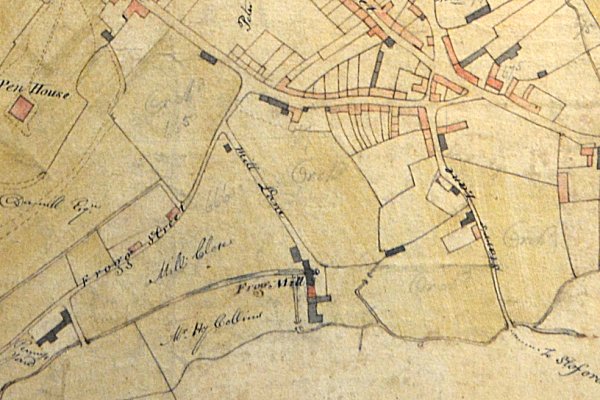
E Watts' map of 1806 shows Frogg Mill, centre bottom, at the end of Mill Lane. At this time the mill belonged to Henry Collins.
gallery
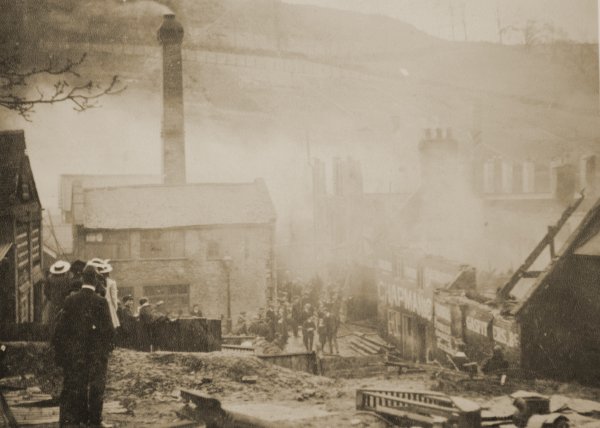
Courtesy of Jack
Sweet
Crowds gather to watch the fire at Chapman's. Photographed 23 April 1909.
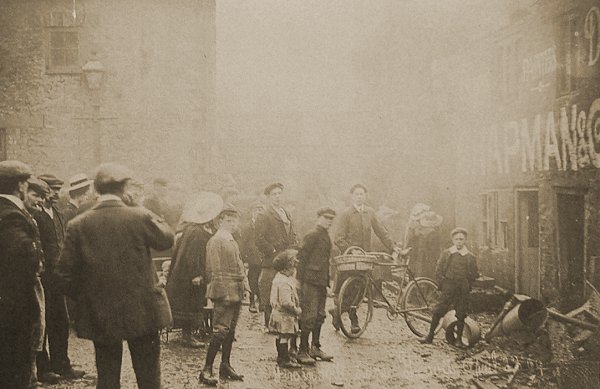
Even before the smoke has cleared, crowds gather to witness the damage caused by the fire. Photographed 23 April 1909.
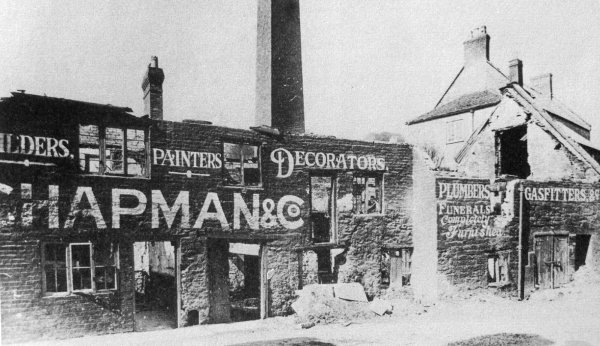
Frogg Mill after the fire of 1909 destroyed the mill buildings.
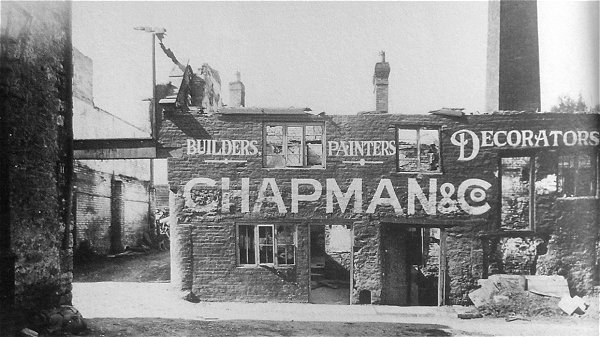
.... and seen from a slightly different position.
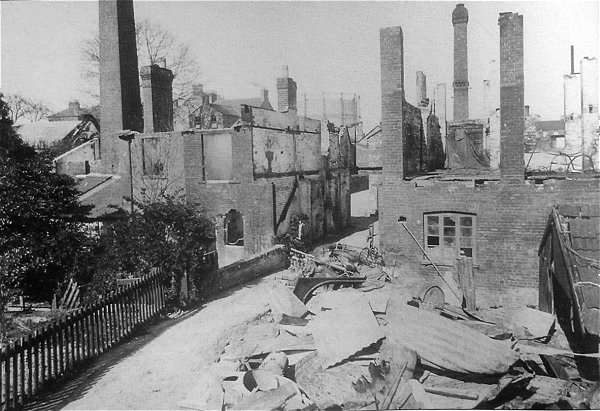
Other buildings destroyed included the Ewens & Johnson leather glove manufactory.
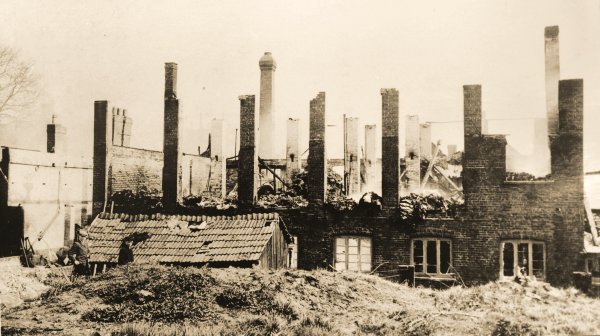
Courtesy of Jack
Sweet
The ruins of the Ewens & Johnson leather glove manufactory. Photographed 23 April 1909.
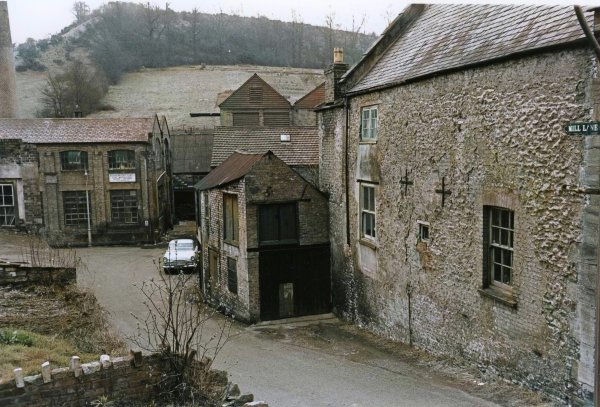
From the Cave
Collection
(colourised),
Courtesy of South Somerset Heritage Collection
This photograph was taken in the mid-1960s from Woodside Terrace at the end of Mill Lane. The small building at centre was all that remained of the former Frogg Mill.

This colourised photograph (looking west) shows water dropping from the original mill leat running between two buildings owned by Ewens & Johnson. The leat provided water for many of the glove factories along its length during the nineteenth century.

The leat turned through 90° and this colourised photograph, looking south, shows the outfall running towards Dodham Brook.